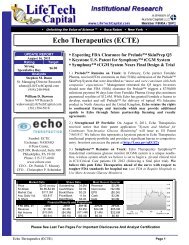NovaBay Pharmaceuticals (NBY) - LifeTech Capital
NovaBay Pharmaceuticals (NBY) - LifeTech Capital
NovaBay Pharmaceuticals (NBY) - LifeTech Capital
You also want an ePaper? Increase the reach of your titles
YUMPU automatically turns print PDFs into web optimized ePapers that Google loves.
www.<strong>LifeTech</strong><strong>Capital</strong>.com December 7, 2010<br />
fungal growth on nails. The novel gel formulations and nanoemulsion lacquers demonstrated significant nail penetration<br />
and antifungal activity following nail penetration indicated by no visual growth and a significant reduction in the CFUs.<br />
Conclusions: In this study we developed and evaluated a novel infected human cadaver nail model and used it to assess<br />
the penetration and activity of selected formulations. Our data showed that NVC-422 gel and nanoemulsion lacquer<br />
formulations, were able to penetrate the nail and eradicate the two most common fungal species causing<br />
onychomycosis. Further evaluation of NVC-422 is warranted.<br />
ICAAC: <strong>NovaBay</strong> presented 4 posters on their Aganocide ® compounds at the 50th Annual Interscience Conference on<br />
Antimicrobial Agents and Chemotherapy (ICAAC) September 12-15, 2010 in Boston.<br />
Poster # and Title: V-420/444 -In Vitro Activity of N-Chlorotaurine (NCT), N-Monochloro-2,2-Dimethyltaurine (NVC-<br />
612) and N,N-Dichloro-2,2-Dimethyltaurine (NVC-422) against Influenza Viruses<br />
Author(s): J. STRÖHLE 1 , M. NAGL 1 , D. DEBABOV 2 , K. HYBISKE 3 , M. ANDERSON 2<br />
1 Innsbruck Med. Univ., Innsbruck, Austria, 2 <strong>NovaBay</strong> <strong>Pharmaceuticals</strong>, Inc., Emeryville, CA, 3 <strong>NovaBay</strong> <strong>Pharmaceuticals</strong>,<br />
Inc., Emeryville, CA.<br />
Background: This study aimed to evaluate the in vitro activity of N-chlorotaurine, an endogenous chloramine compound<br />
produced by human phagocytes. Analogs N-monochloro-2-2-dimethyltaurine (NVC-612) and N,N-dichloro-2,2dimethyltaurine<br />
(NVC-422) were tested for their in vitro virucidal activity against influenza A.<br />
Methods: Influenza H1N1 (Singapore / Hong Kong 2339, 2000; H. Katinger, Vienna), H1N1 (APR-8-38, MicroTest) and<br />
H1N1v (California, 2009; clinical isolate, Innsbruck) were grown on MDCK or Vero cells in RPMI 1640. Cell-free<br />
supernatants containing 106 to 109 plaque forming units (pfu)/ml were incubated at room temperature in solutions of test<br />
substances at different concentrations and times. After inactivation of the oxidants with sodium thiosulfate or serum-free<br />
medium, aliquots were transferred to monolayers of MDCK or Vero cells in serial ten-fold dilutions. Cells were incubated<br />
and monitored for 7-10 days for cytopathic effects.<br />
Results: All three test substances inactivated all viral strains, while the controls with taurine and dimethyltaurine did not<br />
result in reduction of pfu/ml. NCT and NVC-612 (5.5 mM in water) inactivated H1N1 Singapore to the detection limit<br />
after 5 min incubation time (reduction factor > 5 log10), while pfu/ml of H1N1v were reduced by approximately 2 log10<br />
after 5 min and 4 log10 after 10 min. Both strains were inactivated to the detection limit by 55 mM NCT and NVC-612<br />
within 1 min. A 10 min incubation with 10 and 30 mM NVC-422 in water at pH7 reduced the titer of H1N1v by 1 and 2<br />
log 10, respectively. 1 hr treatment with 40 mM NVC-422 in saline pH 4 resulted in 4 log10 reduction.<br />
Conclusions: NCT, NVC-612, and NVC-422 all demonstrated virucidal activity against influenza A. The in vitro<br />
data suggest that H1N1 (Singapore 2000) was slightly more susceptible than H1N1v (California 2009).<br />
Poster # and Title: K-2199/220 Efficacy of NVC-422, a Novel Derivative of N-Chlorotaurine, in Controlling Crystalline<br />
Proteus mirabilis Biofilm Formation on Urinary Catheters<br />
Author(s): S. ABDUL RANI, C. CELERI, D. DEBABOV, M. ANDERSON, R. NAJAFI;<br />
<strong>NovaBay</strong> <strong>Pharmaceuticals</strong>, Emeryville, CA.<br />
Abstract:<br />
Background: Infection by Proteus mirabilis can complicate patient care with long-term indwelling bladder catheters.<br />
These urease-producing bacilli elevate urinary pH, colonize catheters and produce crystalline biofilms that can block the<br />
flow of urine from the bladder. <strong>NovaBay</strong> has developed a non-antibiotic, anti-infective compound (NVC-422; N,Ndichloro-2,2-dimethyltaurine),<br />
a stable derivative of the natural antimicrobial N-chlorotaurine that exhibits potent broad<br />
spectrum antimicrobial activity with an excellent safety profile. Here we investigated the potential use of NVC-422 in an<br />
instillation solution for the control of catheter blockage by P. mirabilis biofilm.<br />
Methods: Experiments were performed in laboratory models of the catheterized bladder fed artificial urine and inoculated<br />
with P. mirabilis. NVC-422 or saline was installed daily into the catheterized bladder chambers following protocols to<br />
simulate clinical bladder washout regimens. The experiments were run for 144h or until catheters blocked. The pH of the<br />
<strong>NovaBay</strong> <strong>Pharmaceuticals</strong> (<strong>NBY</strong>) Page 19



